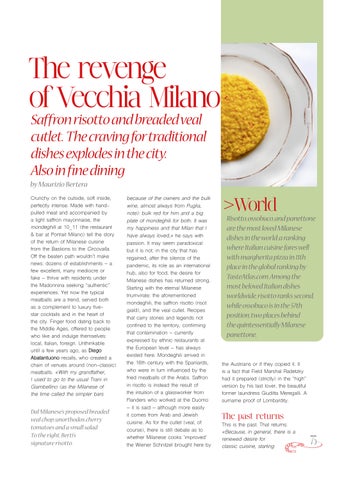The revenge of Vecchia Milano Saffron risotto and breaded veal cutlet. The craving for traditional dishes explodes in the city. Also in fine dining
by Maurizio Bertera Crunchy on the outside, soft inside, perfectly intense. Made with handpulled meat and accompanied by a light saffron mayonnaise, the mondeghili at 10_11 (the restaurant & bar at Portrait Milano) tell the story of the return of Milanese cuisine from the Bastions to the Circovalla. Off the beaten path wouldn’t make news: dozens of establishments – a few excellent, many mediocre or fake – thrive with residents under the Madonnina seeking “authentic” experiences. Yet now the typical meatballs are a trend, served both as a complement to luxury fivestar cocktails and in the heart of the city. Finger food dating back to the Middle Ages, offered to people who like and indulge themselves: local, Italian, foreign. Unthinkable until a few years ago, as Diego Abatantuono recalls, who created a chain of venues around (non-classic) meatballs. «With my grandfather, I used to go to the usual Trani in Giambellino (as the Milanese of the time called the simpler bars
Dal Milanese’s proposed breaded veal chop: unorthodox cherry tomatoes and a small salad To the right, Berti’s signature risotto
because of the owners and the bulk wine, almost always from Puglia, note): bulk red for him and a big plate of mondeghili for both. It was my happiness and that Milan that I have always loved,» he says with
passion. It may seem paradoxical but it is not: in the city that has regained, after the silence of the pandemic, its role as an international hub, also for food, the desire for Milanese dishes has returned strong. Starting with the eternal Milanese triumvirate: the aforementioned mondeghili, the saffron risotto (risot giald), and the veal cutlet. Recipes that carry stories and legends not confined to the territory, confirming that contamination – currently expressed by ethnic restaurants at the European level – has always existed here. Mondeghili arrived in the 16th century with the Spaniards, who were in turn influenced by the fried meatballs of the Arabs. Saffron in risotto is instead the result of the intuition of a glassworker from Flanders who worked at the Duomo – it is said – although more easily it comes from Arab and Jewish cuisine. As for the cutlet (veal, of course), there is still debate as to whether Milanese cooks ‘improved’ the Wiener Schnitzel brought here by
>World
Risotto, ossobuco, and panettone are the most loved Milanese dishes in the world: a ranking where Italian cuisine fares well with margherita pizza in 11th place in the global ranking by TasteAtlas.com. Among the most beloved Italian dishes worldwide, risotto ranks second, while ossobuco is in the 57th position, two places behind the quintessentially Milanese panettone.
the Austrians or if they copied it. It is a fact that Field Marshal Radetzky had it prepared (strictly) in the “high” version by his last lover, the beautiful former laundress Giuditta Meregalli. A surname proof of Lombardity.
The past returns This is the past. That returns: «Because, in general, there is a renewed desire for classic cuisine, starting
75
